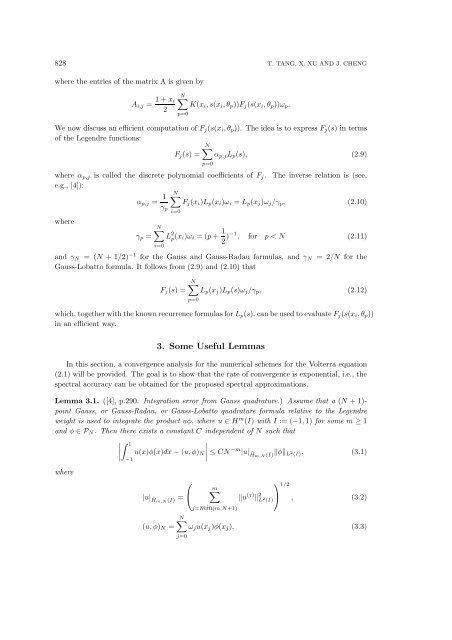On Spectral Methods for Volterra Type Integral Equations and the ...
On Spectral Methods for Volterra Type Integral Equations and the ...
On Spectral Methods for Volterra Type Integral Equations and the ...
Create successful ePaper yourself
Turn your PDF publications into a flip-book with our unique Google optimized e-Paper software.
828 T. TANG, X. XU AND J. CHENG<br />
where <strong>the</strong> entries of <strong>the</strong> matrix A is given by<br />
A i,j = 1 + x i<br />
2<br />
N∑<br />
K(x i , s(x i , θ p ))F j (s(x i , θ p ))ω p .<br />
p=0<br />
We now discuss an efficient computation of F j (s(x i , θ p )). The idea is to express F j (s) in terms<br />
of <strong>the</strong> Legendre functions:<br />
N∑<br />
F j (s) = α p,j L p (s), (2.9)<br />
p=0<br />
where α p,j is called <strong>the</strong> discrete polynomial coefficients of F j . The inverse relation is (see,<br />
e.g., [4]):<br />
where<br />
α p,j = 1 γ p<br />
γ p =<br />
N ∑<br />
i=0<br />
F j (x i )L p (x i )ω i = L p (x j )ω j /γ p , (2.10)<br />
N∑<br />
L 2 p (x i)ω i = (p + 1 2 )−1 , <strong>for</strong> p < N (2.11)<br />
i=0<br />
<strong>and</strong> γ N = (N + 1/2) −1 <strong>for</strong> <strong>the</strong> Gauss <strong>and</strong> Gauss-Radau <strong>for</strong>mulas, <strong>and</strong> γ N = 2/N <strong>for</strong> <strong>the</strong><br />
Gauss-Lobatto <strong>for</strong>mula. It follows from (2.9) <strong>and</strong> (2.10) that<br />
F j (s) =<br />
N∑<br />
L p (x j )L p (s)ω j /γ p , (2.12)<br />
p=0<br />
which, toge<strong>the</strong>r with <strong>the</strong> known recurrence <strong>for</strong>mulas <strong>for</strong> L p (s), can be used to evaluate F j (s(x i , θ p ))<br />
in an efficient way.<br />
3. Some Useful Lemmas<br />
In this section, a convergence analysis <strong>for</strong> <strong>the</strong> numerical schemes <strong>for</strong> <strong>the</strong> <strong>Volterra</strong> equation<br />
(2.1) will be provided. The goal is to show that <strong>the</strong> rate of convergence is exponential, i.e., <strong>the</strong><br />
spectral accuracy can be obtained <strong>for</strong> <strong>the</strong> proposed spectral approximations.<br />
Lemma 3.1. ([4], p.290. Integration error from Gauss quadrature.) Assume that a (N + 1)-<br />
point Gauss, or Gauss-Radau, or Gauss-Lobatto quadrature <strong>for</strong>mula relative to <strong>the</strong> Legendre<br />
weight is used to integrate <strong>the</strong> product uφ, where u ∈ H m (I) with I := (−1, 1) <strong>for</strong> some m ≥ 1<br />
<strong>and</strong> φ ∈ P N . Then <strong>the</strong>re exists a constant C independent of N such that<br />
∫ 1<br />
∣ ∣∣∣ ∣ u(x)φ(x)dx − (u, φ) N ≤ CN −m |u| ˜Hm,N(I) ‖φ‖ L 2 (I), (3.1)<br />
where<br />
−1<br />
⎛<br />
|u| ˜Hm,N(I) = ⎝<br />
(u, φ) N =<br />
m∑<br />
j=min(m,N+1)<br />
⎞<br />
‖u (j) ‖ 2 ⎠<br />
L 2 (I)<br />
1/2<br />
, (3.2)<br />
N∑<br />
ω j u(x j )φ(x j ). (3.3)<br />
j=0

















